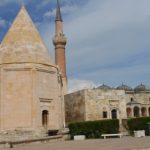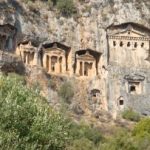The Southern Aegean is the stretch of coastline that stretches from big, bustling İzmir in the north to the small seaside resort of Akyaka in the south.
It’s a part of Turkey that reeks of history, with its single biggest drawcard the ruins of Ephesus, once the capital of the Roman province of Asia Minor, and within easy reach of İzmir, Kuşadası and Selçuk.
Ephesus casts a long shadow that sometimes obscures other less well known gems such as the ruins at Priene, Miletus and Didyma, let alone those at Herakleia-ad-Latmos.
There’s a beach resort at Çeşme, near İzmir, with a very upmarket extension in nearby Alaçatı, but the biggest and best known resort along this stretch of coast is probably Bodrum, the kicking-off point for a myriad Blue Cruises.
Lovers of the Ottoman will find much to enthral them in Şirinçe, near Selçuk, and in the back streets of Old Milas.
Getting there
The quickest way to reach Ephesus is to fly to İzmir, while the speediest access to Bodrum — at least in summer — is via Bodrum International Airport, which is actually closer to Milas. Between the two a network of buses fans out from İzmir’s huge bus terminal: long-distance buses leave from downstairs, those to places in the immediate vicinity from upstairs.
Almost no one who takes a tour of Turkey fails to visit Ephesus, home to some of the most extensive Roman ruins in the world. It was here (or rather in the outskirts of neighbouring Selçuk) that the great Temple of Artemis, one of the Seven Wonders of the Ancient World, once stood, and it was here that St. Paul preached to the Ephesians until driven out by furious local traders. Ephesus ticks all the boxes when it comes to monumental buildings. A huge theatre that’s still in use today? Yep. A glorious library to shame all later models? You bet. There’s even a communal lavatory that sets the mind boggling at what it reveals of the attitudes of a different era. You must pay extra to visit the terraced houses, a collection of homes that were unearthed complete with murals and mosaics that are matched only in Herculaneum in Italy — be sure not to miss them.
The downside? These days Ephesus is way too popular for its own good. On days when cruise ships drop anchor in Kuşadası you may feel that all the 250,000 Romans who once lived here have been reincarnated as tourists jostling each other to snap the ruins.
Most tour groups visit Ephesus from Kuşadası, but for independent travellers the small town of Selçuk, within easy walking distance of the ruins, makes a much nicer base. Not only is it ringed with orchards but within the town itself there are other interesting ruins to be explored, including the Basilica of St. John where the apostle is believed to have been buried. The huge and lovely 14th-century İsa Bey Cami also repays a visit, while for bird-lovers there’s the additional treat of being able to eyeball the storks who take up residence on the town-centre aqueduct every summer. For those on shoestring budgets there’s an excellent choice of accommodation on offer here.
A short dolmuş ride into the hills above Selçuk is Şirince, a beautifully restored Ottoman Greek village where guests at a set of exquisite boutique hotels get the chance to appreciate the rural tranquility after the day trippers have snapped up their lacy souvenirs and departed. It makes a great alternative base for visiting Ephesus.
This trio of ancient ruins can be visited either on organised tours out of Selçuk or Kuşadası, or on a long, do-it-yourself day trip using Söke, the local transport hub, as a base. Priene boasts the remains of a Temple of Athena set high on the hillside with a sweeping view out over the plain of the Büyük Menderes (Meander) River; Miletus has a stunning theatre plus the easily overlooked ruins of the early 15th-century İlyas Bey Cami; while Didim features the ruins of a huge Temple of Apollo that was once the home of a famous oracle. Miletus is extremely difficult to reach by public transport – you might have to factor in some walking and hitching.
A mere 20 years ago Alaçatı was a largely forgotten Ottoman Greek village, near Çeşme, which was full of lovely stone houses. Now almost every one of them has been turned into a boutique hotel or upscale restaurant aimed unabashedly at the elite of Istanbul and Izmir. Come here to gawp, then scuttle back to Çeşme in search of somewhere cheaper to lay your head. This is one of the best places in Turkey for windsurfers.
Cuboid white buildings draped with bougainvillea, a palm-lined promenade overlooking a harbour full of graceful wooden gülets, a nightlife that is famous throughout Turkey and accommodation to suit all budgets — this is beautiful Bodrum, which is also home to the stunning Museum of Underwater Archaeology housed in a monumental castle and the slight remains of the Mausoleum of Halicarnassus, another of the Seven Wonders of the Ancient World. Bodrum’s own beaches are fairly ho-hum but out on the adjacent peninsula there are glorious sands, especially at pretty little Gümüşlük and Bitez, where there’s also a vibrant Sunday brunch scene. Bodrum was the original home to the Blue Cruise and is still one of the best bases to line up a three or four-day boat ride south towards Marmaris.
It crops up in British package-holiday brochures but Akyaka is a particularly appealing small resort on the banks of a river where the local authorities have tried to restrict high-rise development in favour of hotels and pensions in buildings modelled on the traditional architecture of nearby Ula.
Over the last 10 years the centre of İzmir, Turkey’s third largest city, has been made a great deal more inviting, especially along the waterfront where lots of excellent restaurants are poised to soak up the sunset over the bay.
With limited time you may want to give this city of 3 million people a wide berth. It does, though, make a good base for visiting the impressive Lydian ruins at Sardis where coins were first minted and Manisa which has several fine medieval and Ottoman mosques.
If you’re coming to Turkey on a cruise or an organised tour, you may well end up in the big, brash port town of Kuşadası, which is also the best base for hopping across to the Greek island of Samos. The old town boasts a few inviting pensions and there are some good fish restaurants. Otherwise — Bar Street says it all really.
Just south of Kuşadası, the Dilek Peninsula offers a string of small, sandy bays, best visited mid-week, a woody walking trail and the abandoned site of Eski Doğanbey, a less well-known clone of famous Kayaköy, near Fethiye.
North of Milas and inland on the shores of glorious Lake Bafa sits this exquisite slice of rural Turkey where villagers herd their cows along a main street where ancient ruins, modern houses and enormous boulders are so tightly entangled that it’s hard to tell one from the other. An early morning boat trip on the lake is an unforgettable experience, as is a trek in the foothills of the Beşparmak Dağları (mountains) in search of frescoed churches a la Cappadocia.
Hardly any tourists pause en route to Bodrum to explore the back streets of Milas. Were they to do so, however, they would discover a fine array of old Ottoman houses with distinctively soaring brick chimneys. A short taxi ride away is Beçin, where the extensive ruins of the old capital of the 14th- century Menteşe emirs see even fewer visitors. Throw in the Graeco-Roman ruins of nearby Labranda and the more remote ruins of lovely Stratonikeaia, and you’ve more than enough to while away a day or so.

